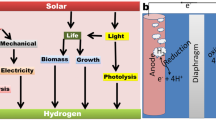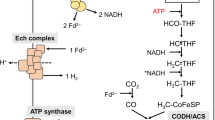Abstract
With rapid technology progress and cost reduction, clean hydrogen from water electrolysis driven by renewable powers becomes a potential feedstock for CO2 fixation by hydrogen-oxidizing bacteria. Cupriavidus necator (formally Ralstonia eutropha), a representative member of the lithoautotrophic prokaryotes, is a promising producer of polyhydroxyalkanoates and single cell proteins. This paper reviews the fundamental properties of the hydrogen-oxidizing bacterium, the metabolic activities under limitation of individual gases and nutrients, and the value-added products from CO2, including the products with large potential markets. Gas fermentation and bioreactor safety are discussed for achieving high cell density and high productivity of desired products under chemolithotrophic conditions. The review also updates the recent research activities in metabolic engineering of C. necator to produce novel metabolites from CO2.


Similar content being viewed by others
References
Alagesan S, Minton NP, Malys N (2018) 13C-assisted metabolic flux analysis to investigate heterotrophic and mixotrophic metabolism in Cupriavidus necator H16. Metabolomics 14:9–19
Aragno M, Schlegel HG (1981) The hydrogen-oxidizing bacteria. In: Starr NP et al (ed) The prokaryotes. Springer, New York, pp 865–893
Ariffin H, Nishida H, Shirai Y et al (2010) Highly selective transformation of poly[R-3-hydroxybutyric acid] into trans-crotonic acid by catalytic thermal degradation. Polym Degrad Stab 95:1375–1381
Badger MR, Bek EJ (2008) Multiple Rubisco forms in proteobacteria: their functional significance in relation to CO2 acqusition by the CBB cycle. J Exp Bot 59:1525–1541
Bae S, Kwak K, Kim S et al (2001) Isolation and characterization of CO2-fixing hydrogen-oxidizing marine bacteria. J Biosci Bioeng 91(5):442–448
Berg IA (2011) Ecological aspects of the distribution of different autotrophic CO2 fixation pathways. Appl Environ Microbiol 77:1925–1936
Boon N, Defoirdt T, De Windt W et al (2010) Hydroxybutyrate and poly-hydroxybutyrate as components of animal feed or feed additives. US Patent 2010/0093860 A1
Bowien B, Kusian B (2002) Genetics and control of CO(2) assimilation in the chemoautotroph Ralstonia eutropha. Arch Microbiol 178:85–93
Brigham CJ, Budde CF, Holder JW et al (2010) Elucidation of β-oxidation pathways in Ralstonia eutropha H16 by examination of global gene expression. J Bacteriol 192:5454–5464
Bugnicourt E, Cinelli P, Lazzeri A et al (2014) Polyhydroxyalkanoate (PHA): review of synthesis, characteristics, processing and potential applications in packaging. Express Polym Lett 8:791–808
Burgdorf T, Lenz O, Buhrke T et al (2005) [NiFe]-hydrogenases of Ralstonia eutropha H16: modular enzymes for oxygen-tolerant biological hydrogen oxidation. J Mol Microbiol Biotechnol 10:181–196
Calloway DH, Kumar AM (1969) Protein quality of the bacterium Hydrogenomonas eutropha. Appl Microbiol 17:176–178
Conrad R (1996) Microorganisms as controllers of atmospheric trace gases (H2, CO, CH4, OCS, N2O, and NO). Microbiol Rev 60:609–640
Crépin L, Lombard E, Guillouet SE (2016) Metabolic engineering of Cupriavidus necator for heterotrophic and autotrophic alka(e)ne production. Metab Eng 37:92–101
Defoirdt T, Boon N, Sorgeloos P et al (2009) Short chain fatty acids and poly-beta-hydroxyalkanoates: (new) biocontrol agents for a sustainable animal production. Biotechnol Adv 27:680–685
Florentino LA, Jaramillo PMD, Silva KB et al (2012) Physiological and symbiotic diversity of Cupriavidus necator strains isolated from nodules of Leguminosae species. Sci Agric 69(4):247–258
Gai CS, Lu J, Brigham CJ et al (2014) Insights into bacterial CO2 metabolism revealed by the characterization of four carbonic anhydrases in Ralstonia eutropha H16. AMB Express 4:2–14
Garcia-Gonzalez L, Mozumder MSI, Dubreuil M et al (2014) Sustainable autotrophic production of polyhydroxybutyrate (PHB) from CO2 using a two-stage cultivation system. Catal Today 257(2):237–245
Garcia-Ochoa F, Gomez E, Santos V et al (2010) Oxygen uptake rate in microbial processes: an overview. Biochem Eng J 49:289–307
Ghysels S, Mozumder MSI, De Wever H et al (2018) Targeted poly(3-hydroxybutyrate-co-3-hydroxyvalerate) bioplastic production from carbon dioxide. Bioresour Technol 249:858–868
Grousseau E, Lu J, Gorret N et al (2014) Isopropanol production with engineered Cupriavidus necator as bioproduction platform. Appl Microbiol Biotechnol 98:4277–4290
Gruber S, Schwab H, Heidinger P (2017) CbbR and RegA regulate cbb operon transcription in Ralstonia eutropha H16. J Biotechnol 257:78–86
Grzeszik C, Jeffke T, Schäferjohann J et al (2000) Phosphoenolpyruvate is a signal metabolite in transcriptional control of the cbb CO2 fixation operons in Ralstonia eutropha. J Mol Microbiol Biotechnol 2:311–320
Huber R, Eder W (2006) Aquificales. In: Dworkin M et al (ed) The prokaryotes: a handbook on the biology of bacteria, vol 7, 3rd edn. Springer, New York, pp 925–928
Hunt AJ, Sin EHK, Marriott R et al (2010) Generation, capture, and utilization of industrial carbon dioxide. Chem Sus Chem 3:306–332
Jugder B-E, Lebhar H, Aguey-Zinsou K-F et al (2016) Production and purification of a soluble hydrogenase from Ralstonia eutropha H16 for potential hydrogen fuel cell applications. MethodsX 3:242–250
Kang S, Yu J (2015a) Reaction routes in catalytic reforming of poly(3-hydroxybutyrate) into renewable hydrogen carbon oil. RSC Adv 5:30005–30013
Kang S, Yu J (2015b) A gasoline-grade biofuel formed from renewable polyhydroxybutyrate on solid phosphoric acid. Fuel 160:282–290
Kang S, Yu J (2015c) Hydrophobic organic compounds from hydrothermal liquefaction of bacterial biomass. Biomass Bioenergy 74:92–95
Kunasundari B, Murugaiyah V, Kaur G et al (2013) Revisiting the single cell protein application of Cupriavidus necator H16 and recovering bioplastic granules simultaneously. PLoS ONE 8(10):e78528. https://doi.org/10.1371/journal.pone.0078528
Kusian B, Sültemeyer D, Bowien B (2002) Carbonic anhydrase is essential for growth of Ralstonia eutropha at ambient CO2 concentrations. J Bacteriol 184:5018–5026
Laeger T, Metges CC, Kuhla B (2010) Role of β-hydroxybutyric acid in the central regulation of energy balance. Appetite 54:450–455
Laycock B, Halley P, Pratt S et al (2013) The chemomechanical properties of microbial polyhydroxyalkanoate. Prog Polym Sci 38:536–583
Lee S-E, Li QX, Yu J (2006) Proteomic examination of Ralstonia eutropha in cellular responses to formic acid. Proteomics 6(15):4259–4268
Li H, Opgenorth PH, Wernick DG et al (2012) Integrated electromicrobial conversion of CO2 to higher alcohols. Science 335:1596–1596
Lu Y, Yu J (2017a) Comparison analysis on the energy efficiencies and biomass yields in microbial CO2 fixation. Process Biochem 62:151–160
Lu Y, Yu J (2017b) Gas mass transfer with microbial CO2 fixation and poly(3-hydroxybutyrate) synthesis in a packed bed bioreactor. Biochem Eng J 122:13–21
Luef KP, Stelzer F, Wiesbrock F (2015) Poly(hydroxy alkanoate)s in medical applications. Chem Biochem Eng Q 29:287–297
Marc J, Grousseau E, Lombard E et al (2017) Over expression of GroESL in Cupriavidus necator for heterotrophic and autotrophic isopropanol production. Metabolic Eng 42:74–84
Mertens R, Liese A (2004) Biotechnological applications of hydrogenases. Curr Opin Biotechnol 15:343–348
Müller J, MacEachran D, Burd H et al (2013) Engineering of Ralstonia eutropha H16 for autotrophic and heterotrophic production of methyl ketones. Appl Environ Microbiol 79(14):4433–4439
Nowotny J, Bak T, Chu D et al (2014) Sustainable practices: solar hydrogen fuel and education program on sustainable energy systems. Int J Hydrog Energy 39:4151–4157
Obruca S, Sedlacek P, Mravec F et al (2016) Evaluation of 3-hydroxybutyrate as an enzyme-protective agent against heating and oxidative damage and its potential role in stress response of poly(3-hydroxybutyrate) accumulating cells. Appl Microbiol Biotechnol 100:1365–1376
Park I, Jho EH, Nam K (2014) Optimization of carbon dioxide and valeric acid utilization for polyhydroxyalkanoates synthesis by Cupriavidus necator. J Polym Environ 22:244–251
Peplinski K, Ehrenreich A, Döring C et al (2010) Genome-wide transcriptome analyses of the Knallgas bacterium Ralstonia eutropha H16 with regard to polyhydroxyalkanoate metabolism. Microbiology 156:2136–2152
Pohlmann A, Fricke WF, Reinecke F et al (2006) Genome sequence of the bioplastic-producing “Knallgas” bacterium Ralstonia eutropha H16. Nat Biotechnol 24:1257–1262
Przybylski D, Rohwerder T, Dilßner C et al (2015) Exploiting mixtures of H2, CO2, and O2 for improved production of methacrylate precursor 2-hydroxyisobutyric acid by engineered Cupriavidus necator strains. Appl Microbiol Biotechnol 99:2131–2145
Rasmussen M, Abdellaoui S, Minteer SD (2016) Enzymatic biofuel cells: 30 years of critical advancements. Biosens Bioelectron 76:91–102
Schlegel HG, Gottschalk G, Von Bartha R (1961) Formation and utilization of poly-[beta]-hydroxybutyric acid by Knallgas bacteria (Hydrogenomonas). Nature 191:463–465
Schröder V, Emonts B, Janβen H et al (2004) Explosion limits of hydrogen/oxygen mixtures at initial pressures up to 200 bar. Chem Eng Technol 27:847–851
Schwartz E et al (2009) A proteomic view of the facultatively chemolithoautotrophic lifestyle of Ralstonia eutropha H16. Proteomics 9(22):5132–5142
Spear JR, Walker JJ, McCollom TM et al (2005) Hydrogen and bioenergetics in the Yellowstone geothermal ecosystem. Proc Natl Acad Sci 102(7):2555–2560
Takeshita T, Ishizaki A (1996) Influence of hydrogen limitation on gaseous substrate utilization in autotrophic culture of Alcaligenes eutrophus ATCC 17697T. J Ferment Bioeng 81:83–86
Tanaka K, Ishizaki A, Kanamaru T et al (1995) Production of poly(D-3-hydroxybutyrate) from CO2, H2, and O2 by high cell density autotrophic cultivation of Alcaligenes eutrophus. Biotechnol Bioeng 45:268–275
Tanaka K, Miyawaki K, Yamaguchi A et al (2011) Cell growth and P(3HB) accumulation from CO2 of a carbon monoxide-tolerant hydrogen-oxidizing bacterium, Ideonella sp. O-1. Appl Microbiol Biotechnol 92:1161–1169
Tiemeyer A, Link H, Weuster-Botz D (2007) Kinetic studies on autohydrogenotrophic growth of Ralstonia eutropha with nitrate as terminal electron acceptor. Appl Microbiol Biotechnol 76:75–81
Torella CJ, Gagliardi JS, Chen DK et al (2015) Efficient solar-to-fuels production from a hybrid microbial/water-splitting catalyst system. Proc Natl Acad Sci USA 112:2337–2342
Valappil S, Misra SK, Boccaccini AR et al (2006) Biomedical applications of polyhydroxyalkanoates, an overview of animal testing and in vivo responses. Expert Rev Med Devices 3(6):853–868
Vandamme P, Coeyne T (2004) Taxonomy of the genus Cupriavidus: a tale of lost and found. Int J Syst Evol Microbiol 54:2285–2289
Volova TG, Kiselev EG, Shishatskaya EI et al (2013a) Cell growth and accumulation of polyhydroxyalkanoates from CO2 and H2 of a hydrogen-oxidizing bacterium, Cupriavidus eutrophus B-10646. Bioresour Technol 146:215–222
Volova TG, Zhila NO, Kalacheva GS et al (2013b) Effects of intracellular poly(3-hydroxybutyrate) reserves on physiological biochemical properties and growth of Ralstonia eutropha. Res Microbiol 164:164–171
Yoon K-S, Fukuda K, Fujisawa K et al (2011) Purification and characterization of a highly thermostable, oxygen-resistant, respiratory [NiFe]-hydrogenase from a marine, aerobic hydrogen-oxidizing bacterium Hydrogenovibrio marinus. Int J Hydrog Energy 36:7081–7088
Yu J (2014) Bio-based products from solar energy and carbon dioxide. Trends Biotechnol 32(1):5–10
Yu J, Plackett D, Chen LXL (2005) Kinetics and mechanism of the monomeric products from abiotic hydrolysis of poly[(R)-3-hydroxybutyrate] under acidic and alkaline conditions. Polym Degrad Stab 89:289–299
Yu J, Dow A, Pingali S (2013) The energy efficiency of carbon dioxide fixation by a hydrogen-oxidizing bacterium. Int J Hydrog Energy 38:8683–8690
Zhila N, Kalacheva G, Volova T (2015) Fatty acid composition and polyhydroxyalkanoates production by Cupriavidus eutrophus B-10646 cells grown on different carbon sources. Process Biochem 50:69–78
Ziogou C, Ipsakis D, Stergiopoulos F et al (2012) Infrastructure, automation and model-based operation strategy in a stand-alone hydrolytic solar-hydrogen production unit. Int J Hydrog Energy 37:16591–16603
Author information
Authors and Affiliations
Corresponding author
Rights and permissions
About this article
Cite this article
Yu, J. Fixation of carbon dioxide by a hydrogen-oxidizing bacterium for value-added products. World J Microbiol Biotechnol 34, 89 (2018). https://doi.org/10.1007/s11274-018-2473-0
Received:
Accepted:
Published:
DOI: https://doi.org/10.1007/s11274-018-2473-0




